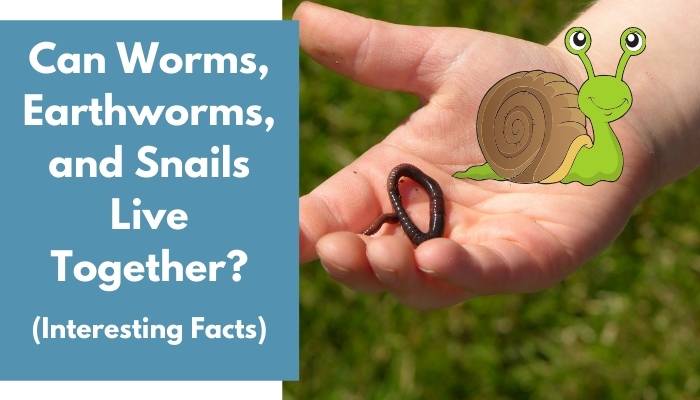Worms, earthworms, and snails share similar areas. If you take a closer look, you’ll find these animals crawling in the same places. For this reason, you may wonder if they can live together, or if they see each other as competition or even food. Thus, you may ask:
Can worms, earthworms, and snails live together? Worms, earthworms, and snails have similar preferences in habitat or environment. Thus, you can say they can live together. Still, they differ in some aspects and only have certain things in common. Both animals are prey, but some worms and snails may eat the other.
Worms, earthworms, and snails prefer moist or damp places. While snails favor crawling on plants, you can see one alongside worms near the ground. For this reason, you may wonder if they both live in harmony.
In this article, we’ll cover more about worms and earthworms and how they deal with snails. This way, you can understand the difference between both and see if they can live side by side.
Without further ado, let’s get into it!
Contents
Do worms and earthworms eat snails?
Worms and earthworms have a special diet, and lucky for snails, they are not on the list.
Worms and earthworms prefer plant-based food and other microorganisms. Such things include dried leaves, rotting vegetation, and even roots.
In general, they only eat what they can find in the ground. Since snails barely come near the bottom and they continuously move, worms won’t eat them.
Of course, some aggressive worms pursue snails. However, these animals only do when a snail is dead or when they ran out of food.
For this reason, worms and earthworms are less likely to eat snails unless they found one lying in the ground.
How do earthworms, worms, and snails coexist?
Worms, earthworms, and snails coexist uniquely. Since they share the same environment preference, it’s no wonder why they benefit from each other.
In essence, earthworms and worms improve the establishment, growth, and cover of plants. They do so by the soil and interactions with other plant species.
On the other hand, snails reduce nitrogen-fixing and increase the cover of plant litter. In short, they reduce ammonia-nitrogen concentrations in the soil.
While it may seem complicated, we can all say that both snails and worms do well to grow and maintain plants and soil around them.
In general, worms help plants by creating burrows and allowing air through them. On the other hand, snails reduce concentrations of ammonia-nitrogen in soil, making it ideal for plants.
While snails and worms have many preferences, they are entirely different from each other.
In general, worms and snails are familiar sights in the garden. Thus, you’ll often find worms in the ground as snails crawl in plants.
Of course, they prefer damp and moist places, primarily because they need to keep themselves moist.
However, snails have shells that protect them from harsh environments. On the other hand, worms protect themselves by burrowing underground.
Both worms and snails come with many differences. Moreover, these two animals originate from different families in the animal kingdom. Thus, you can say they aren’t that much related to each other.
Are slugs OK in a worm farm?
Like snails, slugs are also usual to spot in a worm farm. Since worm farms are always moist or damp, they like the same environment and prefer to stay in it.
Still, it’s not something you need to worry about significantly if you raise worms.
In general, slugs don’t interfere with worms. However, you may want to bury the food scraps, as the slugs may take them away from your worms.
Moreover, burying it will discourage slugs from coming back. These animals may not be a threat, but they can be an invitation to other predators such as birds.
If the birds get the slug, they may also contact the worms in it.
Which is faster – snail or worm?
Snail and worms are both slow animals. Since they crawl all the time and produce slimy substances when moving, they can be relatively quiet. Still, when it comes to which is faster, the worms may be the winner.
A typical snail moves relatively slow since they need to produce slime in the path where they crawl. Thus, if snails encounter a dry surface, they need to make more. In general, snails have a slow speed of 0.0048km/h.
On the other hand, worms dig burrows and crawl in moist soil. Moreover, they have the Setae that helps them move forward.
While these things don’t make them crawl faster, they are a bit ahead of the snails. In general, worms have a conduction velocity of 7.5 m/s or 27km/h.
Summary
Worms, earthworms, and snails have similar preferences in habitat or environment. Thus, they may seem to live together.
In general, they differ in some aspects and only have certain things in common. Both animals are prey, but some worms and snails may eat the other.
Worms, earthworms, and snails prefer moist or damp places. While snails favor crawling on plants, you can see one alongside worms near the ground.
While they do differ in many ways, they both provide benefits for plants and soil around them.



